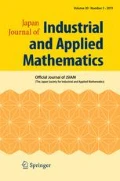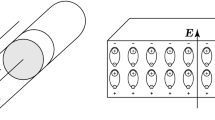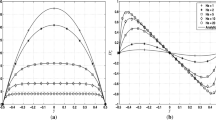Abstract
This paper presents some mixed formulations for finite element analysis of magnetostatic and electrostatic problems. We employ the magnetic and electric fields as fundamental unknowns instead of the vector potential and the scalar potential, and the proposed approach appears to be desirable for three-dimensional finite element analyses. We also give brief comments on the use of the vector potential for the magnetostatic problem.
Similar content being viewed by others
References
F. Brezzi, On the existence, uniqueness and approximation of saddle point problems arising from Lagrangian multipliers. RAIRO,8 (1974), 129–151.
G. Duvaut and J. L. Lions, Inequalities in Mechanics and Physics, Springer Verlag, Berlin-Heidelberg-New York, 1976, Ch. 7
V. Girault and P.-A. Raviart, Finte Element Methods for Navier-Stokes Equations, Theory and Algorithms. Springer-Verlag, Berlin-Heidelberg-New York-Tokyo, 1986, Ch. 1.
S. Kaizu and F. Kikuchi, An imbedding theorem for a Hilbert space appearing in electromagnetics. Sci. Papers College Arts Sci., Univ. Tokyo,36 (1986), 81–89.
F. Kikuchi, An isomorphic property of two Hilbert spaces appearing in electromagnetism: analysis by the mixed formulation. Japan J. Appl. Math.,3 (1986), 53–58.
F. Kikuchi, Mixed and penalty formulations for finite element analysis of an eigenvalue problem in electromagnetism. Computer Methods Appl. Mech. Engrg.,64 (1987), 509–521.
F. Kikuchi, Weak formulations for finite element analysis of an electromagnetic eigenvalue problem. Sci. Papers College Arts Sci., Univ. Tokyo,38 (1988), 43–67.
F. Kikuchi, M. Hara, T. Wada and K. Nakahara, Calculation of RF electromagnetic field by finite element method (III). RIKEN (Institute of Physical and Chemical Research) Accelerator Progress Report,17 (1983), 153–155.
F. Kikuchi and M. P. Navarro, An iteration method for the mixed formulation of parameter dependent problems related to the Stokes equations. Comp. Mech.,1 (1986), 153–155.
R. Leis, Zur Theorie elektromagnetischer Schwingungen in anisotropen inhomogenen Medien. Math. Z.,106 (1968), 213–224.
P. Neittaanmaki and J. Saranen, On the finite element approximation for Maxwell’s problem on polygonal domains. Internat. J. Appl. Anal.,12 (1981), 73–83.
J. A. Stratton, Electromagnetic Theory. McGraw-Hill Inc., New York-London, 1941, Chs. 3 and 4.
N. Weck, Maxwell’s boundary value problem on Riemannian manifolds with nonsmooth boundaries. J. math. Anal. Appl.,46 (1974), 410–437.
Author information
Authors and Affiliations
About this article
Cite this article
Kikuchi, F. Mixed formulations for finite element analysis of magnetostatic and electrostatic problems. Japan J. Appl. Math. 6, 209–221 (1989). https://doi.org/10.1007/BF03167879
Received:
Issue Date:
DOI: https://doi.org/10.1007/BF03167879




